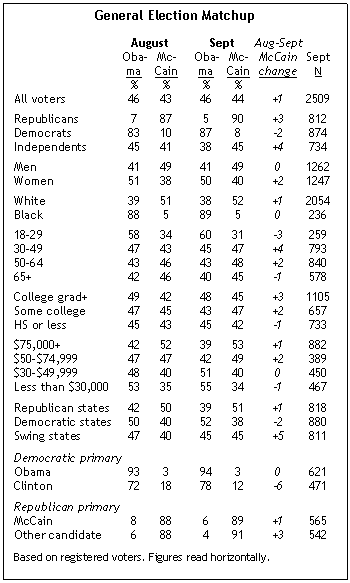
In spite of the huge television audiences for both political conventions and the strongly positive initial public reaction to the selection of Sarah Palin as the Republican vice presidential nominee, the electorate in September divides along most of the same demographic lines as it did prior to the conventions – and very much along the lines on Election Day in 2004. Both candidates solidified support among their own partisans. McCain now has a seven-point edge among independents (45% to 38%); Pew’s poll in August found 45% of independents supporting Obama and 41% favoring McCain.
McCain has made small gains in support among a few other groups, but the basic demographic contours of the election remain stable. Obama continues to lead among women, young voters, African Americans and lower income voters; all of these were groups carried by Kerry in 2004. McCain leads among men, whites and upper income voters, as did Bush four years ago.
McCain did make one potentially significant gain in support over the past month: the race in key battleground states is now tied, 45% for each candidate. Prior to the conventions, Obama held a small but significant 47% to 40% advantage in these important swing states.
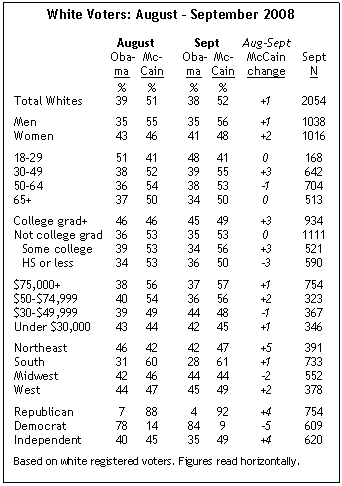
In a positive sign for Obama, an increasing proportion of Democratic primary voters who supported Hillary Clinton now say they will vote for Obama; currently 78% say they will back the Democratic nominee, up from 72% in August. But his level of support among backers of his former rival still falls below the solid backing that McCain is getting from Republicans who favored another candidate for the nomination (91%).
Among white voters overall, McCain leads Obama 52% to 38%; based on voters who expressed a preference between the two candidates, McCain’s lead is 58%-42%, almost identical to Bush’s margin over Kerry among white voters in 2004 (58%-41%).
McCain also has statistically significant advantages among several important subgroups of white voters, including both men and women; voters ages 30 and older; southerners; independents; and voters who do not have a four-year college degree. Among other groups of white voters, however, Obama is competitive, including voters younger than 30; college graduates; and white voters living outside of the South.
Religion and the Vote
Religious affiliation and commitment are somewhat more strongly associated with voter support now than was the case a month ago. In particular, McCain now holds a clear lead (52% to 36%) among white non-Hispanic Catholics who attend Mass at least weekly. In August, this group was much more closely divided (McCain 45%, Obama 42%). Less observant Catholics remain equally split between the candidates, as they were last month. In 2004, Bush won among all white Catholic voters by a margin of 56%-43%.
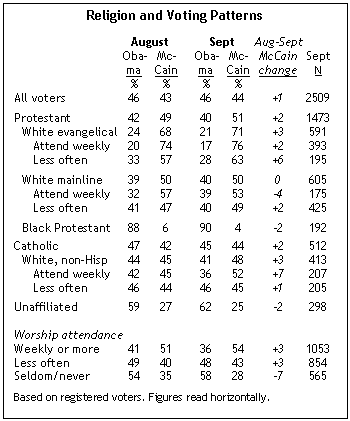
McCain’s support among white evangelical Protestants, a key Republican group that gave 78% support to Bush in his battle for reelection, has inched up now to 71% (vs. 21% for Obama). In June, 61% supported McCain. Even more notable is the increased strength of support for McCain among evangelicals.
Meanwhile, Obama leads by 90%-4% among black Protestants, and has a solid lead (62%-25%) among secular and unaffiliated voters. Among white mainline Protestants, McCain leads by 50% to 40%, about the same as last month.
Little Change Among Women Voters
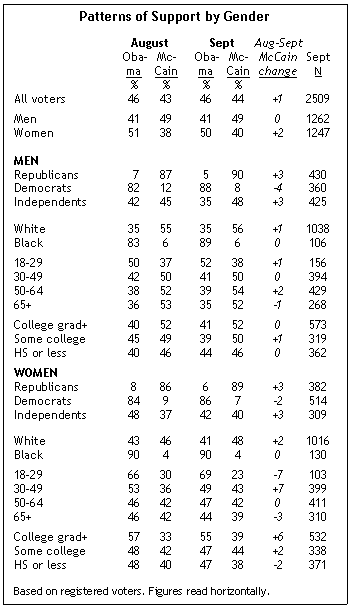
There has been no significant movement toward McCain among women voters generally – or among white women voters in particular – following the GOP convention and his selection of Palin as his vice-presidential running mate.
However, the McCain-Palin ticket now does slightly better among women ages 30 to 49. In August, Obama held a 53% to 36% advantage over McCain among women in this age group. Following the conventions, his lead has narrowed slightly to 49%-43%, reflecting a gain of seven points in support for McCain.
Obama continues to hold a very large lead among younger women, 69% to 23%.
Republicans Energized

While the overall horserace has been largely unchanged in the past few months, there has been an increase in strong support for McCain. Among all voters in August, 17% said they supported McCain strongly; currently, 25% support McCain strongly. Moreover, the increases in strong support are concentrated among key Republican voter groups.
Strong support jumped 16 percentage points among Republican voters overall, and 21 points among Republicans who had supported someone other than McCain in the primaries. It grew by 13 points among white evangelical Protestants, increasing from 28% in August to 41% after the conventions.
Obama made gains in strength of support among some of his key groups as well, though the magnitude of the change was not as great as for McCain. Prior to the convention, Obama’s support was much stronger than McCain’s (27% strong vs. 17% for McCain); now 30% strongly support Obama, compared with 25% for McCain. Notably, strong support for Obama among former backers of Hillary Clinton grew 12 points, from 29% to 41%.
Voting “for” the Candidates
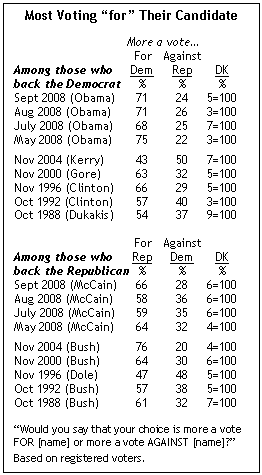
Large majorities of supporters of both candidates continue to say that their choice is more a vote for their candidate than against the other candidate. Among McCain’s backers, 66% now say their vote is more a vote for him than against Obama, up eight points from August when 58% said this. But the proportion of positive votes for McCain still trails the 76% that George W. Bush received in the 2004 election. It is comparable to positive votes for Bush in 2000 (64%).
Obama continues to attract more positive than negative votes. Currently 71% of his supporters say they are voting more for him than against McCain, unchanged from last month. Throughout the campaign season since Obama moved ahead of Clinton, Obama’s positive support has generally exceeded that of other Democratic presidential nominees of the past two decades. In particular, just 43% of John Kerry’s voters in 2004 said they were voting more for him than against Bush. In Bill Clinton’s re-election campaign, 66% of his voters were positive rather than negative, higher than in his 1992 election (57%).
Percentage of Swing Voters Declines
Slightly more than a quarter of registered voters (27%) say they are undecided or might change their mind in November, down from 33% in last month’s poll. Currently, 38% say they are certain to vote for Obama and 35% for McCain. The swing voter group includes three separate kinds of voters: 8% who are either leaning to Obama (3%) or say they intend to vote for him but might pick McCain (5%); 9% who are leaning to McCain (4%) or say they intend to vote for him but might change their mind and vote for Obama (5%); and 10% who are completely undecided in the race.
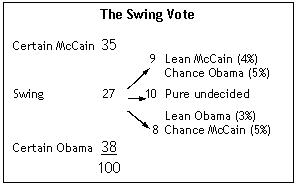
The size of the swing vote in the aftermath of the conventions is slightly larger than it was four years ago at this time. In the aftermath of the political conventions in 2004, 24% of voters fell into the swing category.
The most ideological partisans are the least likely to be swing voters, with 15% of conservative Republicans and just 12% of liberal Democrats falling into this group. But significant numbers of swing voters remain among the more moderate members of each party. Among moderate and liberal Republicans, 29% remain somewhat less than certain about their vote, and the comparable number among conservative and moderate Democrats is 24%.
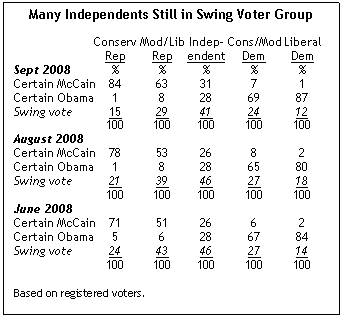
As is usually the case, large numbers of independents remain in the swing voter category. In the current poll, 41% are not yet certain of their choice, down five points from last month. McCain holds a slight edge among the “decided” independents, with 31% saying they are certain to vote for him and 28% saying this about Obama. McCain also has a slight edge in leaning and less solid supporters (14% for McCain, 11% for Obama). Among independents, 17% of voters remain completely undecided.
Swing Voters’ Attitudes
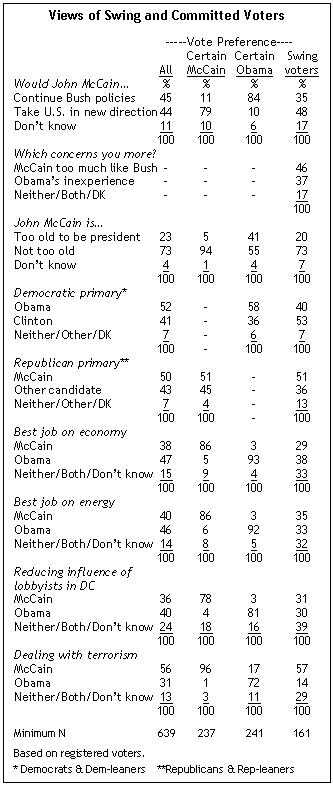
Swing voters remain similar to the rest of the electorate with respect to gender, age, income, marital status, and other personal characteristics. They are about evenly divided in terms of partisanship (41% identify as Democrats or lean Democratic, 38% identify as Republicans or lean to the GOP).
Swing voter views of the candidates offer little clear guidance as to how they might eventually vote. They are evenly divided as to which candidate can best reduce the influence of lobbyists and special interests in Washington and on the question of which candidate is best on the energy issue. By 38% to 29%, swing voters favor Obama over McCain on the economy. A much larger majority of 57% says McCain can do a better job of protecting the country from another terrorist attack; just 14% of swing voters pick Obama on this measure.
Nearly half of swing voters (48%) say that McCain would take the country in a different direction from Bush; 35% believe he would continue to pursue Bush’s policies. But when swing voters were asked outright what concerned them more, 46% said it was the possibility that McCain would govern too much like Bush; 37% were more concerned that Barack Obama lacks experience.
Reasons for Supporting Obama, McCain
The supporters of both Obama and McCain cite issues more frequently than any other reason why they would like to see their preferred candidate win in November. But beyond issues, Obama and McCain voters cite very different factors.
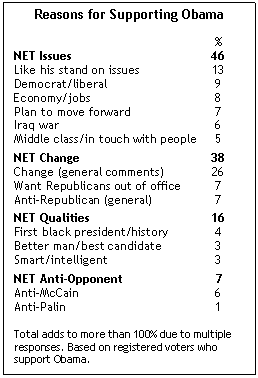
Nearly as many Obama supporters (38%) make some reference to a desire for change as a reason for choosing him. Fully 26% simply say that the country needs a change, or indicate the Obama can bring change. One-in-seven (14%) specifically cite dissatisfaction with Republican management of the country, President Bush, or both.
Far fewer Obama voters (16%) cite his personal qualities as the main reason they are supporting him: 4% mention that he would be the first black president, while 3% say simply he is the better man or better candidate. Only 7% cite negative things about John McCain (6%) or his running mate (1%) as reasons for supporting the Democratic candidate.
In contrast, McCain supporters mention his personal qualities (41%) nearly as frequently as they mention issues (46%). In particular, McCain’s experience is cited by 17% of his supporters. In addition, 6% say they favor McCain because he is a moral person or has Christian values. An equal percentage (6%) specifically cites McCain’s running mate, Sarah Palin, as a reason for supporting him. And 3% cite his background as a veteran and war hero.

More than one-in-ten (13%) McCain supporters cite opposition to Obama as a reason for voting for McCain. Most of these (9%) make general negative comments about Obama, while 3% cite Obama’s inexperience. A small percentage of McCain voters (2%) also mention change as the main reason they would like to see him win the election.
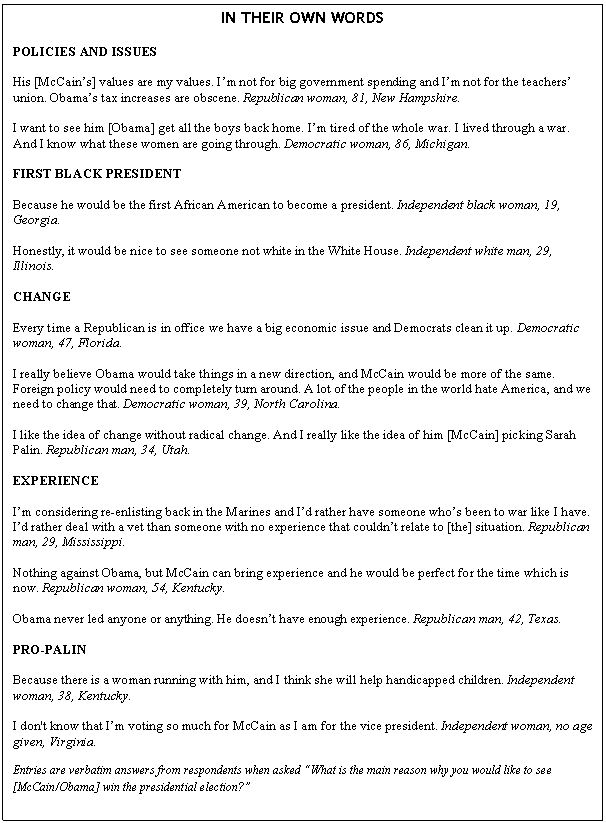
Satisfaction with the Candidates
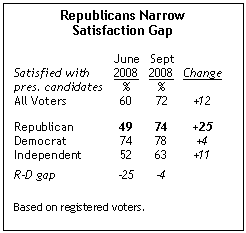
Almost three-quarters of registered voters say they are very (24%) or fairly (48%) satisfied with their choices for president this election cycle. This is up 12 percentage points from June, and is the highest level of satisfaction with the candidates since Pew began asking the question during the 1992 presidential campaign.
The increase in satisfaction with the candidates has been driven largely by Republicans. Currently, 74% of Republican voters say they are satisfied with their choices for president, up 25 points from June. The shift has been even greater among Republican and Republican-leaning voters who supported a candid ate other than John McCain in the GOP primaries (65% now vs. 35% in June).
The boost has dramatically reduced the satisfaction gap between Republicans and Democrats. In June, significantly more Democrats than Republicans reported being very or fairly satisfied with their choices for president (74% v. 49%, respectively). That 25-point gap has narrowed to a four-point gap, with 78% of Democrats and 74% of Republicans now expressing satisfaction with the field.
Among religious groups, white evangelical Protestants express much greater satisfaction with the candidates than they did in June. Currently, more than two-thirds of white evangelical voters (68%) say they are satisfied with the presidential candidates, up from just 44% in June. While in June white evangelicals were far less positive about the field than were white mainline Protestants and white non-Hispanic Catholics, that gap has mostly disappeared in the current survey.
Candidates Addressing Important Issues?
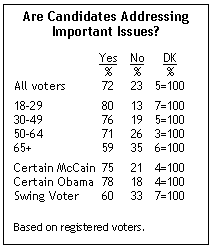
A large majority of voters (72%) say that the presidential candidates have been talking about issues important to them in the campaign. The percentage saying that the candidates are focusing on important issues is now greater than it was at this point in the 2004 campaign (64%) and the same as in September 2000 (72%).
Currently, 80% of voters under age 30 say the candidates are addressing issues that are important to them. By contrast, substantially fewer voters ages 65 and older (59%) say the candidates are talking about the issues that are important to them.
Swing voters are less likely than those who say they are certain about their vote choice to say that the candidates are focusing on important issues. Six-in-ten swing voters express this view, compared with 78% of certain Obama voters and 75% of certain McCain voters.
Increasing Republican Confidence
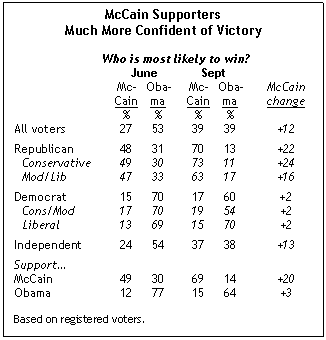
Republican voters emerged from their convention much more confident of victory in the fall elections than they were earlier this year. Currently, 70% say they expect John McCain to win the election, up from just 48% in June. By contrast, Democrats are now somewhat less certain of victory: 60% now say Obama is more likely to win, a decline of 10 points since June. Overall, voters divide evenly (39% for each candidate) in their prediction of who will win.
About one-in-five voters (22%) remain uncertain about the outcome. This is similar to the level of uncertainty four and eight years ago, when the country was also going through closely contested presidential elections. At this time in 2004, most voters (60%) thought Bush would win, while 22% said Kerry was most likely to win and 18% declined to offer a prediction.
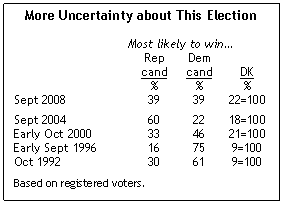
In early October 2000, a plurality of 46% predicted victory for Democratic candidate Al Gore. In surveys later that fall, however, pluralities said Bush was more likely to win.